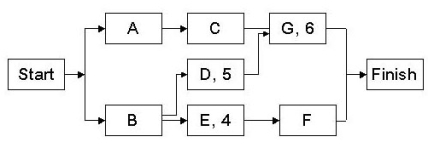Use the following network diagram and table to answer parts (a) through (d).

(a) Under "normal" conditions: what is the earliest the project can be completed; what is the critical path; what is the cost?
(b) Suppose you wanted to complete the project one week earlier than under normal conditions. What activity(ies) would you have to speed up. How much would it add to the cost of the project?
(c) Under "crash" conditions: what is the earliest the project can be completed; what is the minimum it will cost to complete it in this time.
(d) The costs in part (a) through (d) are direct costs. Suppose overhead costs are determined by the formula C = 4000 + 2000t, where t is the project duration in weeks. Using this formula, what are the total project costs (direct plus indirect) for the project durations you got in parts (a) and (d)? Based on a cost comparison, should the project be completed under normal conditions, crash conditions, or somewhere in between?
Correct Answer:
Verified
Q19: Statement: Although the times used in PERT
Q20: Statement: In the critical path method (CPM),
Q21: Statement: The cost slope is the marginal
Q22: Statement: Indirect costs include administrative, overhead, and
Q23: Statement: A "resource loading" chart shows the
Q24: Statement: In resource loading, the project schedule
Q25: Statement: It is relatively easy to level
Q27: The Following Questions adapted from tutorial material
Q28: The Following Questions adapted from tutorial
Q29: The Following Questions adapted from tutorial
Unlock this Answer For Free Now!
View this answer and more for free by performing one of the following actions

Scan the QR code to install the App and get 2 free unlocks

Unlock quizzes for free by uploading documents